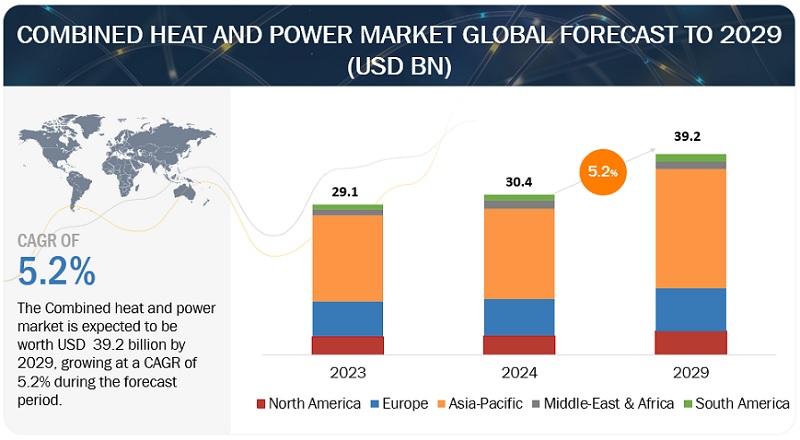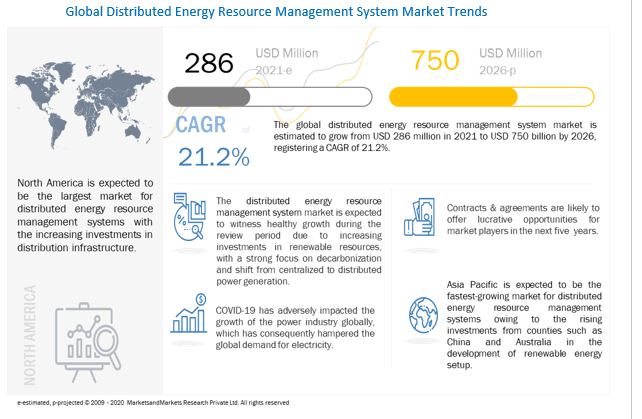According to a research report "Micro Combined Heat and Power Market by Technology (IC Engine, PEMFC, Rankine Cycle Engine, Stirling Engine, SOFC), Type (Engine, Fuel Cell), Application (Residential, Commercial), Capacity (<5kW, 5–10kW, 10–50kW) and Region - Global Forecast to 2029" published by MarketsandMarkets, the Micro Combined heat and power market is projected to reach USD 4.8 billion by 2029 from an estimated USD 3.1 billion in 2024, at a CAGR of 9.4% during the forecast period.
The demand for Micro combined heat and power (MCHP) is growing due to its efficiency in generating electricity and capturing waste heat for heating or cooling purposes, reducing energy costs and emissions. It offers benefits like increased energy efficiency, lower operational costs, and enhanced grid resilience. MCHP systems are used in various sectors like commercial, and residential complexes to meet energy needs sustainably.
Download PDF Brochure @ https://www.marketsandmarkets.com/pdfdownloadNew.asp?id=419
Residential, by Application, is expected to grow by the largest segment during the forecast period.
Based on application, the micro combined heat and power market has been segmented into residential and commerical. The residential segment of Micro CHP market is expected to grow the largest due to rising environmental awareness among homeowners, promoting sustainable and energy-efficient solutions. Micro CHP systems, by generating heat and electricity simultaneously, enhance energy efficiency and reduce reliance on traditional power sources, appealing to environmentally conscious consumers. Technological advancements have made these systems more accessible and affordable, further driving their adoption. Moreover, government incentives and regulatory support aimed at clean energy adoption provide additional impetus for homeowners to invest in Micro CHP systems.
The < 5 kW segment by Capacity is expected to grow fastest during the forecast period.
This report segments the micro combined heat and power market based on capacity into <5Kw, 5-10kW, 10-50kW. The <5kW segment is expected to grow as the fastest in the micro combined heat and power market due to advancements in technology that have resulted in more efficient and cost-effective smaller-scale units. These systems are tailored to meet the energy demands of residential and small commercial buildings, catering to a growing trend towards decentralized energy generation. Government incentives and policies further support this growth by promoting small-scale renewable and efficient energy technologies. Additionally, the flexibility and on-site energy generation capabilities of <5kW Micro CHP systems make them highly appealing to users seeking to reduce transmission losses and improve overall energy efficiency, driving their accelerated adoption.
Europe is expected to be the second largest growing region in the micro combined heat and power market.
Europe is expected to be the second largest growing region in Micro combined heat and power market during the forecast period. The Europe region has been subdivided into five key countries: Germany, UK, Italy, Netherlands and Rest of Europe. Rest of Europe includes Belgium, Denmark, and Spain.
The Micro combined heat and power market is flourishing in the Europe due to strong emphasis on sustainability and energy efficiency, promoting the adoption of Micro CHP systems. The region's well-established market infrastructure for renewable energy technologies, coupled with supportive government policies, incentives, and subsidies, further fuels market growth.
Request Sample Pages: https://www.marketsandmarkets.com/requestsampleNew.asp?id=419
Key Players
Some of the major players in the Micro Combined heat and power market are AISIN CORPORATION (Japan), 2G Energy (Germany), BOSCH INDUSTRIEKESSEL GMBH (Germany), KyungDong Navien (South Korea), and YANMAR HOLDINGS CO., LTD. (Japan). The major strategies adopted by these players include sales contracts, product launches, investments, collaborations, partnerships, and expansions.
Browse Related Reports:
Fuel Cell Market by Type (PEMFC, SOFC, PAFC, MFC, DMFC, AFC), Application (Portable, Stationary, Vehicle (FCVs)), End User (Residential, C&l, Transportation, Data Center, Military & Defense), Size, Fuel, Component and Region - Global Forecast to 2028
Combined Heat and Power Market by Prime Mover (Gas Turbine, Steam Turbine, Reciprocating Engine, Fuel Cell, Microturbine), Capacity (Up to 10 MW, 10-150 MW, 151-300 MW, Above 300 MW), Fuel, End User and Region - Global Forecast to 2029


/image%2F4763514%2F20210127%2Fob_47e87b_chp-market.jpg)
